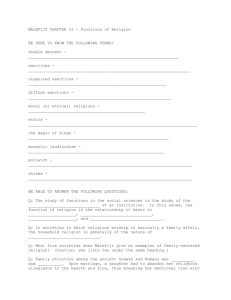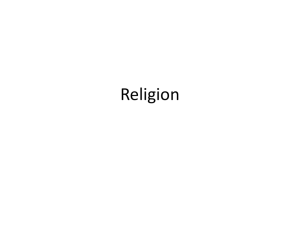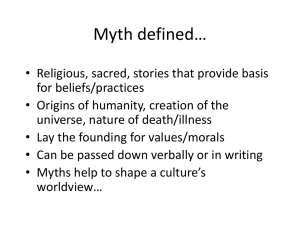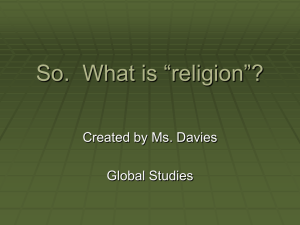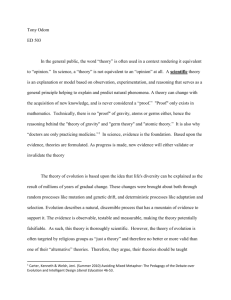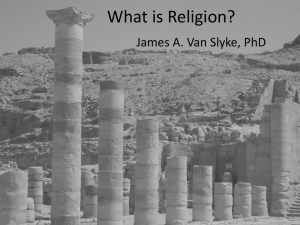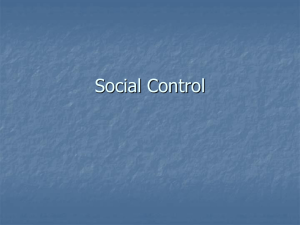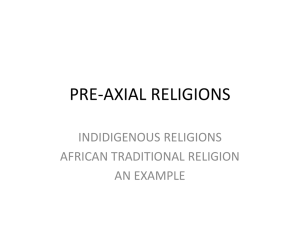Unit 6 - Religion and Magic
advertisement
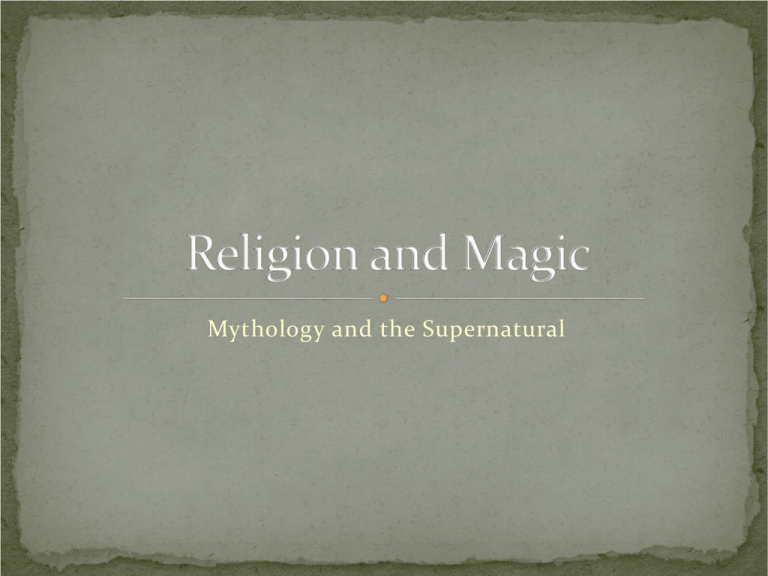
Mythology and the Supernatural What is the purpose of religion from an anthropological perspective? What is religion? “Any set of attitudes, beliefs, and practices pertaining to supernatural power, whether they be forces, gods, spirits, ghosts, or demons” Simple definition, extremely difficult cultural concept Associated with all known contemporary societies Evidence of religious practices 60,000 years ago in early homo sapiens Anthropological concerns/questions: Why is religion found in all societies? How and why does it vary from society to society? Most believe religion is a human creation in response to certain needs (4): Intellectual understanding, reversion to childhood feelings, anxiety and uncertainty, and a need for community First 3 theories deal with psychological needs Understanding the world around us, and our place in it Last theory (need for community) – Emile Durkheim Humans living in societies feel pushed and pulled to act a certain way Religion arises out of this to affirm a person’s place in society, enhance community, and give people confidence Example: totem animals In aboriginal societies in Australia, an animal comes to represent the social group The animal on its own isn’t significant (lizard, rat, frog, etc.) but it’s representation of the social group is significant to that society Types of supernatural forces and beings Many societies in Polynesia believe in mana Supernatural, impersonal force thought to inhabit some objects and people, but not others Think The Force in Star War…more on this later Is there anything like this in our society? Very similar to superstitions (ex. A baseball player’s “lucky bat” or a four-leaf clover) Idea of a taboo is very similar to mana Difference: objects with mana are to be touched; taboo objects are not, for their power can cause harm Types of supernatural forces and beings Supernatural beings fall into two categories: nonhuman and human origin Nonhuman: gods and spirits Human: ghosts and ancestral spirits Types of supernatural forces and beings Gods Beliefs usually that gods created themselves, then created other things (other gods, the world, humans, plants and animals, etc.) Examples Maori of New Zeland believe in 3 gods: sea, forest, agriculture They call on each god as needed Ancient Romans: much more specialized There were 3 gods just for the plow, one for sowing seeds, one for weeding, one for storing grain, one for manuring, etc… Types of supernatural forces and beings Spirits Usually below gods in prestige Guardian spirits, mischievous spirits (hobgoblins) Sanpoil N.A.’s of Washington sent little boys and girls out overnight to acquire their Guardian spirits Types of supernatural forces and beings Ghosts and ancestor spirits The idea that ghosts can be perceived by humans is almost universal across cultures! Explanations? Many cues in everyday life that evoke remembrance of a loved one (smells, pictures, dreams, etc.) No coincidence that ghosts are usually close relatives, not strangers Judaism, Christianity, and Islam – all believe in one god However, there is room for other supernatural beings (ex. The Devil, angels, demons, etc.) Why do some societies have a belief in a “high god” and others do not? G.E. Swanson: cross-cultural study of 50 societies Societies with complex social hierarchy (ex. Family, clan, cheifdom) – 17 out of 20 believed in a “high god” Societies without complex social hierarchy – 2 out of 19 believed in a “high god” Conclusion? Strong suggestion that the realm of the gods parallels and reflects everyday social and political worlds How do people interact with the supernatural? A short list (not exhaustive): Prayer (asking for supernatural help) Physiological experience (doing things to the body and mind; ex. trances) Simulation (manipulating imitations of things) Feasts Sacrifices Different than prayer Prayer is asking; magic is compelling the supernatural to act in some intended way We tend to associate this with “simpler” societies Keep in mind – over 80,000 people in the U.S. take magic seriously, and claim to be witches Magic is often employed in societies to bring about cures as well as to cause harm Ju-ju charm protecting a canoe in Suriname, 1954 Central to many societies’ daily lives Azande of Zaire (DRoC) Used to explain the unexplainable A man is gored by an elephant. He must have been bewitched, because he’s never been gored by an elephant before A man goes to his beer hut at night, lights some straw on fire, holds it up to see his beer, and his hut catches on fire. Must be witchcraft, since he has done this hundreds of times before, and his hut never caught on fire A skilled potter produces a bowl and it cracks. Witchcraft Cultural roots of witch craft One theory: political turmoil and fear of others The witch craze of Europe (think Salem 1692) In 1692 the government of Mass. was falling apart. No governor, and judicial practices broke down Led to the accusation of hundreds, and the execution of 20 Another theory? Disease Ergot (a fungus) when eaten can cause hallucinations (it contains LSD). Symptoms are very similar to what we saw from the “witches” of Salem Could have cultural roots Why does witchcraft appear in so many societies? Beatrice Whiting: found in societies which lack procedures to deal with crime and other offenses Basically, if you do something wrong the person you wronged can cause you ill-will Very similar to karma Incan society: if you do something wrong, you can bring destruction to your entire village. Great social control. Shaman: part-time male specialist who is involved in healing (usually has high status in society) Enters into a trance, journeys to other worlds in order to get help from guardians or spirits Sorcerers and witches: invoke supernatural forces to cause harm or ill-will (usually low social and economic status) Mediums: very similar to shaman, but usually female Urarina Shaman, Amazonian rainforest, 2006 Priests: full-time male specialists who are able to relate to gods beyond the ordinary person’s control (usually high status) Dependence on memorized ritual protects the priest If a shaman repeatedly fails to cure illness, he will probably lose his following If a priest performs his ritual perfectly and the gods choose not to respond, the priest will retain his position and the ritual will preserve its assumed effectiveness Are religions adaptive? They should be, right? If the purpose of religion is to reduce the anxieties of a people, the religion should adapt to changes in society Contradictions to this Hindu belief in cows as sacred May seem to be the opposite of an adaptive custom However, it is possible that the benefits of a live cow still outweigh the benefits of a slaughtered cow Revival religions = efforts to save a dying culture (perceived or real) The Seneca and the Religion of Handsome Lake (ca. 1799, New York) Handsome Lake and his text, the Gaiwiio (“Good Word”) Preached the evils of sin, and the path to salvation by temperance (drunkenness was a huge problem among the Seneca), peace and social unity, preservation of tribal lands, proacculturation (such as learning English), and domestic morality Led to a rapid revival among the Seneca Agricultural production improved 10-fold, temperance was widely accepted, public health and hygiene dramatically improved Handsome Lake church still exists to this day Cargo Cults – and Yali’s Question Though there are many differences from religion to religion, there are also many “archetypes” Across cultures, the great hero’s and tales often have the same components Joseph Campbell: “The Hero With a Thousand Faces” Cross-cultural analysis of world religions Conclusion: the monomyth “A hero ventures forth from the world of common day into a region of supernatural wonder: fabulous forces are there encountered and a decisive victory is won: the hero comes back from this mysterious adventure with the power to bestow boons on his fellow man.” – Joseph Campbell Three sections: Departure, Initiation, and Return Not all myths have all components of the monomyth Can be only partial, out of order, etc. Examples: Osiris (Egyptian), Prometheus (Greek), the Buddha (Indian), Moses (Judeo-Christian), Christ (Christian) All over the place Many books and movies are based, either consciously or unconsciously, on the monomyth Literature: The Odyssey, Lord of the Rings, Beowulf, Siddhartha, Harry Potter, etc. Music: Jerry Garcia, Jim Morrison, and Bob Dylan all attribute much of their music to Campbell’s book Film: Aladdin, The Lion King, The Matrix Perhaps the best (and most direct) example is Star Wars George Lucas used The Hero… deliberately in writing the scripts How can we, from an anthropological perspective, account for the universality of religion? What is the purpose of religion?

